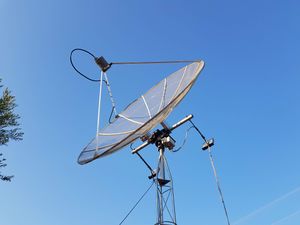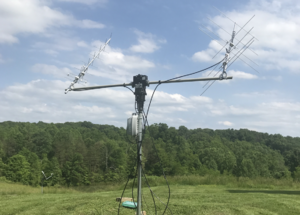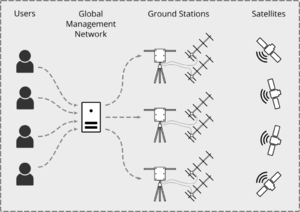Difference between revisions of "Main Page"
(restructure) |
m (Fixed typo he -> the) (Tag: Visual edit) |
||
| (16 intermediate revisions by 4 users not shown) | |||
| Line 1: | Line 1: | ||
<p>__NOTOC__</p> | <p>__NOTOC__</p> | ||
| − | <p>SatNOGS is an integral part of the [https://libre.space Libre Space Foundation]. The project aims to build a global network of satellite ground stations. | + | [[File:SatNOGS_explanation.png|right|300x300px]][[File:Station-1000.jpg|alt=S-Band dish on AZ/EL rotator.|right|thumb|Ground Station with S-Band dish on AZ/EL rotator. [https://network.satnogs.org/stations/1000 SatNOGS Station #1000]]]<p><big>[https://satnogs.org SatNOGS]</big> is an integral part of the [https://libre.space <big>Libre Space Foundation</big>]. The project aims to build a global network of satellite ground stations. It is designed as an open source participatory project based on the users operating a ground station that is accessed via a web page for all of the network users. A basic ground station can be made up of commercial off the shelf components that are commonly available with a static [[Omnidirectional Station How To|omnidirectional antenna]], to more complex stations with multiple movable antennas.</p> |
| − | <p>If you would like to build your own ground station and have limited knowledge then it is recommended that you follow a non-rotator build with a simple RTL-SDR dongle and a Raspberry Pi. This will get you on to the network quickly and allow you to start scheduling observations. There are a few choices to be made but | + | [[File:AZ EL Ground Station.png|alt=AZ/EL Ground Station with VHF and UHF Antennas|left|thumb|Yaesu G-5500 Az/El Rotator w/ M2 VHF/UHF Antennas. [https://network.satnogs.org/stations/2 SatNOGS Station #2]]] |
| − | <p>The reference design uses a Raspberry Pi | + | <p>If you would like to build your own ground station and have limited knowledge then it is recommended that you follow a [[Omnidirectional Station How To|non-rotator build]] with a simple RTL-SDR dongle and a [[Raspberry Pi]]. This will get you on to the network quickly and allow you to start scheduling observations. There are a few choices to be made but the community are available to help if you need it. More complex, movable, antenna systems can be steered with either the SatNOGS designed rotator or a commercial unit such as the Yaesu G-5500, Spid XY or similar. It is recommended that these types of builds are for more experienced operators but there is no reason why these can not be put into operation, they just require more work.</p> |
| − | + | <p>The reference design uses a Raspberry Pi + RTL-SDR dongle + either a VHF or UHF antenna. A [[Raspberry Pi]] image is available to make software installation simpler. Much of the decision making is down to personal choice but sometimes additional hardware is needed to help filter out local noise, such as strong broadcast stations. Both the community and Matrix / IRC offer support and assistance.</p> | |
| − | |||
| − | |||
| − | |||
| − | |||
| − | |||
| − | |||
| − | |||
| − | |||
| − | |||
| − | |||
| − | |||
| − | |||
| − | |||
| − | |||
| − | |||
| − | |||
| − | |||
| − | |||
| − | |||
| − | |||
| − | |||
| − | |||
| − | |||
| − | |||
| − | |||
| − | |||
| − | |||
| − | |||
| − | |||
| − | |||
| − | |||
| − | |||
| − | |||
| − | |||
| − | + | [[Category:Community]] | |
| + | [[Category:Build]] | ||
| + | [[Category:Hardware]] | ||
| + | [[Category:Software]] | ||
| + | [[Category:Operate]] | ||
| + | [[Category:Main]] | ||
| + | [[Category:Develop]] | ||
| + | [[Category:Infrastructure]] | ||
| + | [[Category:Satellite]] | ||
Latest revision as of 01:17, 1 August 2021

SatNOGS is an integral part of the Libre Space Foundation. The project aims to build a global network of satellite ground stations. It is designed as an open source participatory project based on the users operating a ground station that is accessed via a web page for all of the network users. A basic ground station can be made up of commercial off the shelf components that are commonly available with a static omnidirectional antenna, to more complex stations with multiple movable antennas.

If you would like to build your own ground station and have limited knowledge then it is recommended that you follow a non-rotator build with a simple RTL-SDR dongle and a Raspberry Pi. This will get you on to the network quickly and allow you to start scheduling observations. There are a few choices to be made but the community are available to help if you need it. More complex, movable, antenna systems can be steered with either the SatNOGS designed rotator or a commercial unit such as the Yaesu G-5500, Spid XY or similar. It is recommended that these types of builds are for more experienced operators but there is no reason why these can not be put into operation, they just require more work.
The reference design uses a Raspberry Pi + RTL-SDR dongle + either a VHF or UHF antenna. A Raspberry Pi image is available to make software installation simpler. Much of the decision making is down to personal choice but sometimes additional hardware is needed to help filter out local noise, such as strong broadcast stations. Both the community and Matrix / IRC offer support and assistance.
